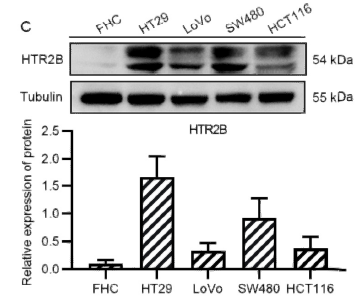
Catalog: YT4398
Size
Price
Status
Qty.
200μL
$450.00
In stock
0
100μL
$280.00
In stock
0
40μL
$150.00
In stock
0
Add to cart


Collected


Collect
Main Information
Target
SR-2B
Host Species
Rabbit
Reactivity
Human
Applications
WB, IF, ELISA
MW
54kD (Observed)
Conjugate/Modification
Unmodified
Detailed Information
Recommended Dilution Ratio
WB 1:500-1:2000; IF 1:200-1:1000; ELISA 1:10000; Not yet tested in other applications.
Formulation
Liquid in PBS containing 50% glycerol, 0.5% BSA and 0.02% sodium azide.
Specificity
SR-2B Polyclonal Antibody detects endogenous levels of SR-2B protein.
Purification
The antibody was affinity-purified from rabbit antiserum by affinity-chromatography using epitope-specific immunogen.
Storage
-15°C to -25°C/1 year(Do not lower than -25°C)
Concentration
1 mg/ml
MW(Observed)
54kD
Modification
Unmodified
Clonality
Polyclonal
Isotype
IgG
Related Products
Antigen&Target Information
Immunogen:
The antiserum was produced against synthesized peptide derived from human HTR2B. AA range:15-64
show all
Specificity:
SR-2B Polyclonal Antibody detects endogenous levels of SR-2B protein.
show all
Gene Name:
HTR2B
show all
Protein Name:
5-hydroxytryptamine receptor 2B
show all
Other Name:
HTR2B ;
5-hydroxytryptamine receptor 2B ;
5-HT-2B ;
5-HT2B ;
Serotonin receptor 2B
5-hydroxytryptamine receptor 2B ;
5-HT-2B ;
5-HT2B ;
Serotonin receptor 2B
show all
Background:
This gene encodes one of the several different receptors for 5-hydroxytryptamine (serotonin) that belongs to the G-protein coupled receptor 1 family. Serotonin is a biogenic hormone that functions as a neurotransmitter, a hormone, and a mitogen. Serotonin receptors mediate many of the central and peripheral physiologic functions of serotonin, including regulation of cardiovascular functions and impulsive behavior. Population and family-based analyses of a minor allele (glutamine-to-stop substitution, designated Q20*) which blocks expression of this protein, and knockout studies in mice, suggest a role for this gene in impulsivity. However, other factors, such as elevated testosterone levels, may also be involved. Alternatively spliced transcript variants have been found for this gene. [provided by RefSeq, Mar 2016],
show all
Function:
Function:This is one of the several different receptors for 5-hydroxytryptamine (serotonin), a biogenic hormone that functions as a neurotransmitter, a hormone, and a mitogen. This receptor mediates its action by association with G proteins that activate a phosphatidylinositol-calcium second messenger system.,similarity:Belongs to the G-protein coupled receptor 1 family.,subunit:Interacts with MPDZ.,tissue specificity:Detected in most peripheral organs. Only low expression levels were found in the brain.,
show all
Cellular Localization:
Cell membrane ; Multi-pass membrane protein . Cell junction, synapse, synaptosome .
show all
Tissue Expression:
Ubiquitous. Detected in liver, kidney, heart, pulmonary artery, and intestine. Detected at lower levels in blood, placenta and brain, especially in cerebellum, occipital cortex and frontal cortex.
show all
Research Areas:
>>Calcium signaling pathway ;
>>Neuroactive ligand-receptor interaction ;
>>Gap junction ;
>>Serotonergic synapse ;
>>Inflammatory mediator regulation of TRP channels
>>Neuroactive ligand-receptor interaction ;
>>Gap junction ;
>>Serotonergic synapse ;
>>Inflammatory mediator regulation of TRP channels
show all
Signaling Pathway
Reference Citation({{totalcount}})
Catalog: YT4398
Size
Price
Status
Qty.
200μL
$450.00
In stock
0
100μL
$280.00
In stock
0
40μL
$150.00
In stock
0
Add to cart


Collected


Collect
Recently Viewed Products
Clear allPRODUCTS
CUSTOMIZED
ABOUT US
Toggle night Mode
{{pinfoXq.title || ''}}
Catalog: {{pinfoXq.catalog || ''}}
Filter:
All
{{item.name}}
{{pinfo.title}}
-{{pinfo.catalog}}
Main Information
Target
{{pinfo.target}}
Reactivity
{{pinfo.react}}
Applications
{{pinfo.applicat}}
Conjugate/Modification
{{pinfo.coupling}}/{{pinfo.modific}}
MW (kDa)
{{pinfo.mwcalc}}
Host Species
{{pinfo.hostspec}}
Isotype
{{pinfo.isotype}}
Product {{index}}/{{pcount}}
Prev
Next
{{pvTitle}}
Scroll wheel zooms the picture
{{pvDescr}}




















